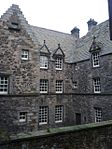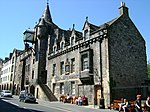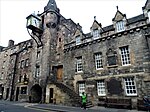Centre for Open Learning, University of Edinburgh
Education in EdinburghSchools of the University of EdinburghUse British English from April 2017

The Centre for Open Learning (COL) the home of Short Courses, English Language Education, International Foundation Programme, Summer School, Winter School and Access programme at the University of Edinburgh. The Centre is based at Paterson's Land on the University of Edinburgh's Holyrood Campus.
Excerpt from the Wikipedia article Centre for Open Learning, University of Edinburgh (License: CC BY-SA 3.0, Authors, Images).Centre for Open Learning, University of Edinburgh
Holyrood Road, City of Edinburgh Old Town
Geographical coordinates (GPS) Address Phone number Website Nearby Places Show on map
Geographical coordinates (GPS)
| Latitude | Longitude |
|---|---|
| N 55.95 ° | E -3.18 ° |
Address
Paterson's Land
Holyrood Road
EH8 8AQ City of Edinburgh, Old Town
Scotland, United Kingdom
Open on Google Maps











